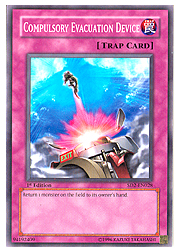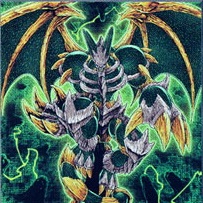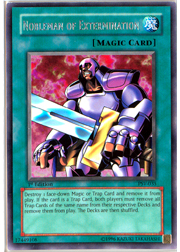There was so much going on at Shonen Jump Championship Baltimore that there was no way I could cover it all. I actually had several articles half-completed and then shelved simply due to time restrictions, not the least of which was a short multi-interview piece asking top players about their three favorite Synchros and a deck profile on Nicholas Nunez’s Canceller Gadget build. But the most obvious omission was a tech update.
That’s a shame, because some of the weekend’s best tech actually didn’t make it to Day 2, and wasn’t covered in feature matches. Other cards that would’ve been featured in a tech article that weekend did make it to Day 2, but simply remain underappreciated by the posting masses in online forums. The kicker? None of these cards are intricate enough on their own to comprise their own article, leaving me in a bit of a spot.
So let’s just look at them all! Today I want to show you the sleeper tech from Baltimore: they’re all cards you should be considering when you build your decks, and though you’ve probably thought about some of them already, none of them are seeing the level of play they probably should be. Let’s start with one of my top picks . . .
Compulsory Evacuation Device
There was a ton of creativity on display at Baltimore, but if I’m remembering the blur that was my weekend correctly, the first place I saw this card was in Comic Odyssey’s Gladiator Beast build. Eric Wu and Hugo Adame had opted to forego newer cards in order to explore older tech options, and this was  one of their best choices. Several other duelists were running it as well, but none of them managed to make Day 2.
one of their best choices. Several other duelists were running it as well, but none of them managed to make Day 2.
In the past, Compulsory Evacuation Device was written off as "a minus one" in terms of card presence—a card that consumes itself upon resolving, but doesn’t actually get rid of an opponent’s card. Indeed, if you send a normal monster or an effect monster back to your opponent’s hand, he or she can just summon it again later. Unless that monster was a tribute monster, the opponent hasn’t lost anything but tempo.
But times have changed since the Device’s release in Invasion of Chaos. Back then you’d never see a Fusion monster in a competitive deck (unless it was brought out with Magical Scientist) and Synchros didn’t exist. Nowadays things are different: Gladiator Beast Gyzarus continues to be a huge force in any competitive metagame, and Synchros are pretty much everywhere. This shift has made Compulsory Evacuation Device a totally different card.
Kicking back a low-investment monster to your opponent’s hand might still not be the strongest of moves, but at the same time there are lots of instances in which it will save you from losing a card anyway—namely when you face Gladiator Beasts. If you control a face-down copy of Compulsory Evacuation Device and you’re attacked by a Gladiator, you may as well just knock it back to your opponent’s hand: you’re going to lose your one card to Gladiator Beast Bestiari’s effect anyway.
But it’s the power of Fusion and Synchro monsters that really make this card shine. Shunt Gladiator Beast Gyzarus back to your opponent’s Extra deck and even if Gyzarus destroyed another of your cards, you’ve managed to trade that card and your Device for the two Gladiator Beasts your opponent contact Fused. The same goes for Synchro monsters: with Teleport Dark Armed leading the pack, you’ll usually see two cards being used to Synchro summon one monster, and even if one of the Synchro materials happens to be Destiny Hero - Malicious, you’re still trading your Device straight across for the Emergency Teleport or Krebons your opponent had to expend.
And boy, is it worth it! People are thinking very hard about their defensive lineups these days, because the threat of Stardust Dragon is changing everyone’s perspective. The word "destroy" is now a detractor in many respects. It might as well read "Stardust Dragon negates me: try and find something else to play." Cards like Compulsory Evacuation Device, which can send Stardust back to the Extra deck (and can’t be negated by the Dragon’s effect), have gained a lot of play value. Sure, Dimensional Prison could remove the Dragon from play, but the Prison isn’t chainable, and requires an attack from the Dragon to take it down. Compulsory Evacuation Device can eliminate Stardust as soon as it hits the field, and it’s a lot cheaper to activate than the other trap card capable of doing so: Solemn Judgment.
Compulsory Evacuation Device is a chainable, cost-free answer to some of this format’s biggest threats. While Phoenix Wing Wind Blast is the Synchro-tech of choice for anything that wants to discard Destiny Hero - Malicious, any other strategy should be considering Evacuation Device instead.
Thought Ruler Archfiend
Of course, the one Synchro monster that Compulsory Evacuation Device can’t lay a finger on is this guy. A top pick for competitors like Dale Bellido, Cesar Gonzalez, and many more, it  dodges everything that Stardust Dragon can’t—if it targets, it can’t touch Thought Ruler Archfiend.
dodges everything that Stardust Dragon can’t—if it targets, it can’t touch Thought Ruler Archfiend.
That means that a lot of the tech choices being made specifically to stop Stardust Dragon, like Dimensional Prison, Compulsory, Wind Blast, and spells like Book of Moon and Enemy Controller, are just straight-up outplayed by a duelist that can make the right read and summon Thought Ruler instead. Summoning Thought Ruler against your opponent’s single back-row card can often mean game if he or she doesn’t have Solemn Judgment or Bottomless Trap Hole set.
It’s not complicated—Thought Ruler can win you games that you wouldn’t win with any other Synchro monster, and including it in your Extra deck costs you essentially nothing from a game-play perspective. It counters the big metagame tech choices that are being made right now, and it’s pretty cheap to pick up on the secondary market. Since it’s one of the few Synchros not slated for an upcoming reprint, I’d highly recommend picking up two or three copies now, before everybody notices and the price jumps.
Colossal Fighter
Speaking of price jumps, here’s one card that you’ll never have to worry about paying a double-digit sum for. Colossal Fighter tops the list of reasons to pick up the Yu-Gi-Oh! 5D’s Starter Deck, offering a short list of high-impact tricks that no other Synchro wields. Want to swing over Gladiator Beast Heraklinos? Red Dragon Archfiend can trade with the Gladiator heavy-hitter, but odds are good that you’ll find at least three Warriors between the two graveyards of each player. If you can only find two, even better—that’ll bump Colossal Fighter up to 3000 ATK, and when it trades with Heraklinos in battle you can special summon it back to the field for another immediate attack. The same trick works on Judgment Dragon.
Colossal Fighter is also the number-one Synchro answer to Honest. The fact that Honest can boost any Light monster over Stardust Dragon or Thought Ruler Archfiend can be a real kick in the teeth, but if you know your opponent is holding Honest, just Synchro summon Colossal Fighter and swing into the smallest Light monster in attack position: your opponent will either have to let the monster go and suffer whatever damage Colossal Fighter is threatening to deal, or drop Honest for a paltry amount of damage. If he or she does the latter, Colossal Fighter can special summon itself back to the field: you take some damage, but the opponent loses his or her card. If there’s a second monster on the field the Fighter can then attack that instead.
Colossal Fighter is likely one of the best Synchros in the game: again, like Thought Ruler it was another popular top-three pick for high-profile players in Baltimore. Since you can get one in every Yu-Gi-Oh! 5D’s Starter Deck there’s no reason you shouldn’t have two.
Magical Android
The only super rare Synchro monster in The Duelist Genesis finishes out my trifecta of underappreciated Synchros. While Magical Android isn’t a hard-hitting powerhouse like Colossal Fighter, nor a sweet metagame bullet-dodger like Thought Ruler, it’s still incredibly useful in the right matchup—you should be playing at least one copy.
There are times when Synchro summoning Magical Android just happens to be exactly what you need to do in order to win. Either it’s the only play you have after playing Mind Control or Brain Control on an opposing Krebons, or it just so happens that you have five levels of monsters including a spare Tuner while your opponent has 2400 or fewer life points. Those situations are rare compared to the times when you’d like to drop Stardust or Thought Ruler, but they do happen once or twice a tournament. So it’s got that going for it—it’s the only level 5 Synchro and it’s an auto-in as a result.
But the real reason to play Magical Android is the burn matchup. Most burn decks these days are banking heavily on the potential 1000 damage a turn from a single copy of Wave-Motion Cannon—either as a finisher after a flurry of early burn cards, or as a complete win condition in and of itself. It’s here where Magical Android shines. Even if you don’t main-deck any Psychic monsters, the Android is a Psychic type, meaning you’ll get 600 life points every turn it’s on the field. Wave-Motion Cannon just isn’t very good when it’s basically dealing only 400 damage a turn. It means you’ve got about double the length of time you would otherwise have to draw into your answers, and dig for a win.
Again, it’s cheap, unique, and there’s no reason you shouldn’t be using it.
Nobleman of Extermination
This near-ancient trap card rounds out my top five picks from Baltimore, and while it’s been around for a very long time, this is the first format where I’d seriously consider playing it. There are lots of trap cards being played in multiples that are exceptionally good to knock  out of the duel. Rid the game of Gladiator Beast War Chariot and the number-one card you need to tiptoe around in the Gladiator Beast matchup is suddenly gone. Removing all of your opponent’s Bottomless Trap Hole or Dimensional Prison cards is pretty good, too.
out of the duel. Rid the game of Gladiator Beast War Chariot and the number-one card you need to tiptoe around in the Gladiator Beast matchup is suddenly gone. Removing all of your opponent’s Bottomless Trap Hole or Dimensional Prison cards is pretty good, too.
But with the right deck, the feel-good hit when you activate this card is most certainly Solemn Judgment. Either your opponent is forced to activate it in response, or he or she has to give up the most feared trap in the game. Since it’s virtually always run in threes, it usually represents the biggest blow you can deal to your opponent’s defensive lineup. If you run something that doesn’t play Solemn itself, Nobleman of Extermination is nothing short of brilliant. Like Jerome said last week, every deck in this format needs a way to force out Solemns. If you’ve never played Teleport Dark Armed Dragon and had your opponent Solemn your Stratos, you don’t know just how good that card can be in this format.
None of these cards are expensive, but they can all cause a lot of havoc in this format. Each is currently an inexpensive addition to your play box, and I’d really suggest nabbing two or three copies of each right now while the getting’s good. There’s so much room for innovation, and so much interplay between tech cards in this format, that you’ll need to have every option at your disposal. These are five must-own cards right now: keep them in mind when you build your next deck.
—Jason Grabher-Meyer